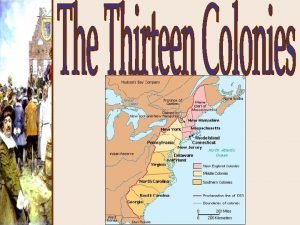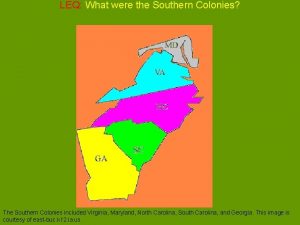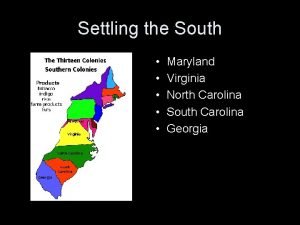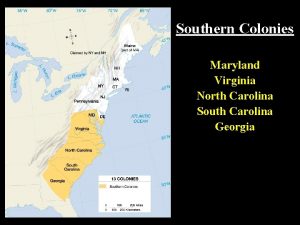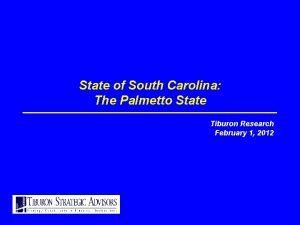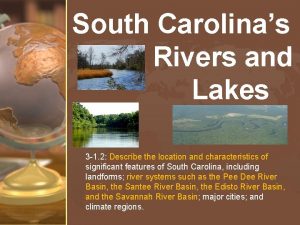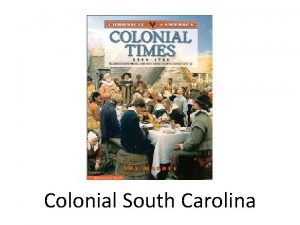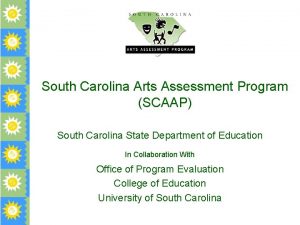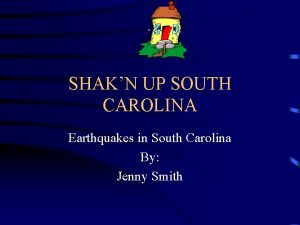Colonial South Carolina Study Guide Completed Colonial South









- Slides: 9

Colonial South Carolina Study Guide Completed

Colonial South Carolina Study Guide Definitions • • • A) Gullah –language that involves a mixture of African and English dialects, spiritual folktales, and basket weaving B) Stono Rebellion- largest slave rebellion in colonial America (SC) that failed. It caused the Slave Codes to be created to restrict slaves’ freedom C) Slave Codes- rules developed to restrict the rights and movements of slaves; prevent future rebellions )D) Rice “Carolina Gold”- rice was known as “Carolina Gold” because of the amount of wealth it brought to the state; cash crop E) Indigo- a staple crop grown for dye produce from it developed by Liza Lucas Pinckney F) Regulators- Up country vigilantes that put an end to crime and disorder in the area, and establish the control of government. Operated outside the law to create order

Colonial South Carolina Study Guide Definitions • G) Vigilante -person who takes the law into their own hands, avenging a crime • H) Head right System-encouraged immigration by giving land to every person who paid their passage to the New World • I) Census- total count of a population in an area • J) Staple Crop- rice, indigo, and cotton • K) Middle Passage-transatlantic voyage of African slaves to the Americas. Millions died due to horrible living conditions, lack of food, water, or suicide. • L) Up Country (Back Country)-farmers owned small farms with very few or no slaves; started at the fall line and went upward towards the Blue Ridge mountains; less educated people

Colonial South Carolina Study Guide Definitions • M) Low Country- located near the coast and was characterized by large plantations, with wealthy, educated Englishmen. • N) Mercantilism- Mother Country(England) controlled trade-export more than import became more wealthy and powerful. • O) Subsidy/Bounty- business a payment from the government to support a business • P) Salutary neglect- when the British government does not enforce the laws of the land as long as they received what they needed • Q) Enumerated list -a list of products that could only be sold to England

Colonial South Carolina Study Guide Major Concepts • 1) How did Barbados contribute to the plantation system used in Colonial South Carolina? The plantation system used to grow sugarcane in Barbados was very similar to the system used to grow rice and indigo in SC. This island sent settlers and slaves to Carolina. • 2) Why was South Carolina so dependent on slave labor? To work on huge, labor intensive plantations. Slaves had knowledge of growing rice and raising cattle. What crops were grown? Rice, indigo • 3) What were the causes and effects of the Stono Rebellion? Treatment of the slaves started a revolt. Outcome were the slave codes which restricted slaves’ rights and their movement

Colonial South Carolina Study Guide Major Concepts • 4) What is mercantilism? Mother Country (England) controlled trade-export more than import became more wealthy and powerful. What is the relationship between South Carolina and the Mother Country? . Source of raw materials and a market for manufactured goods. • 5) What were the major reasons settlers in South Carolina wanted to switch from a proprietary to a royal colony? Proprietors did not give protection from Spanish, Native Americans, and thieves. How did the government structure change as a result? Royal Colony were the governor is appointed by the King. • 6) Who launched the Regulator Movement? Upcountry Explain the purpose of this movement. To protect the Upcountry settlers and provide some type of law enforcement. What ended it? Seven Circuit Courthouses were set up to provide law and order. Circuit Court Act

Colonial South Carolina Study Guide Major Concepts • 7) Why was the African population very high in South Carolina? Slaves to work plantations Why was this a concern for the white plantation owner? There were slaves then whites so they could rebel. • 8) Who helped developed indigo as a staple crop? Liza Lucas Pinckney What is indigo used for? - a staple crop grown for dye produce from it

Colonial South Carolina Study Guide Major Concepts • (9) Compare and Contrast the elements of the Lowcountry and Upcountry (Backcountry) in Colonial SC. (Agriculture, social, economic) • See next slide of Venn Diagram

Venn Diagram comparing the Low Country and Up Country • Located on coast • Easy to transport goods • Many slaves • Wealthy • Lawmakers/governor • More population • Well educated • Farm crops for profit • • • Under Proprietary rule-King Charles Part of SC Charter Both farm crops • Few slaves , if any • Hard to travel/longer time to move goods • Small farms • High crime(no protection) • Poor • Regulators • Less formally educated • No representation /little say in government • Farm crops for subsistence(survival)
 Georgia, south carolina, north carolina, virginia, maryland
Georgia, south carolina, north carolina, virginia, maryland What is this image
What is this image Maryland virginia north carolina south carolina and georgia
Maryland virginia north carolina south carolina and georgia Virginia, maryland, north carolina, south carolina, georgia
Virginia, maryland, north carolina, south carolina, georgia Cathedral 50 miles southwest of paris completed in 1220
Cathedral 50 miles southwest of paris completed in 1220 South carolina state firefighters association
South carolina state firefighters association Tiburon, south carolina
Tiburon, south carolina South carolina major rivers
South carolina major rivers South carolina state tax withholding form
South carolina state tax withholding form Types of turtles in sc
Types of turtles in sc
